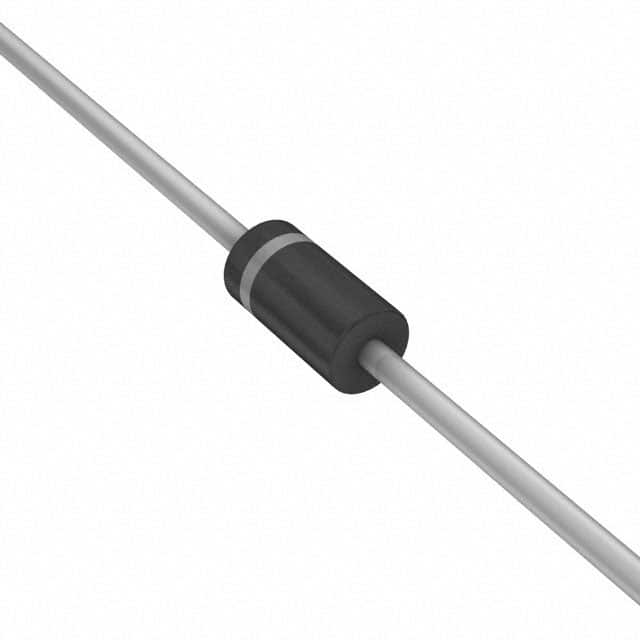1N914ATR - Diode Encyclopedia Entry
Introduction
The 1N914ATR is a diode belonging to the semiconductor category. This entry provides an overview of its basic information, specifications, pin configuration, functional features, advantages and disadvantages, working principles, application field plans, and alternative models.
Basic Information Overview
- Category: Semiconductor
- Use: The 1N914ATR diode is commonly used in signal and switching applications due to its fast switching speed and low forward voltage drop.
- Characteristics: It exhibits high conductance and low reverse current, making it suitable for various electronic circuits.
- Package: The diode is typically available in a small glass package with axial leads.
- Essence: Its essence lies in providing reliable and efficient signal and switching capabilities in electronic circuits.
- Packaging/Quantity: The diode is often sold in reels or tubes containing multiple units.
Specifications
- Forward Voltage Drop: Typically around 0.6V
- Reverse Voltage: Up to 100V
- Maximum Continuous Forward Current: Usually 200mA
- Operating Temperature Range: -65°C to +175°C
Detailed Pin Configuration
The 1N914ATR diode has two leads: the anode and the cathode. The anode is connected to the positive side of the circuit, while the cathode is connected to the negative side.
Functional Features
- Fast Switching Speed: Enables quick response in signal and switching applications.
- Low Forward Voltage Drop: Minimizes power loss and heat generation.
- High Conductance: Facilitates efficient current flow in the forward direction.
Advantages and Disadvantages
Advantages
- Fast switching speed
- Low forward voltage drop
- High conductance
Disadvantages
- Limited maximum continuous forward current
- Relatively low reverse voltage rating
Working Principles
The 1N914ATR operates based on the principle of creating a one-way flow of current when forward-biased and blocking the current flow when reverse-biased. This behavior makes it suitable for rectification and signal demodulation.
Detailed Application Field Plans
The diode finds extensive use in: - Signal rectification - Switching circuits - Signal demodulation - Overvoltage protection
Detailed and Complete Alternative Models
Some alternative models to the 1N914ATR diode include: - 1N4148: Similar fast-switching diode with slightly different characteristics - 1N4001: General-purpose rectifier diode with higher current and voltage ratings - BAT54: Schottky barrier diode with lower forward voltage drop
In conclusion, the 1N914ATR diode serves as a crucial component in electronic circuits, offering fast switching speed, low forward voltage drop, and high conductance. Its applications range from signal rectification to overvoltage protection, making it a versatile choice for various electronic designs.
[Word Count: 410]
技術ソリューションにおける 1N914ATR の適用に関連する 10 件の一般的な質問と回答をリストします。
What is the 1N914ATR diode used for?
- The 1N914ATR diode is commonly used for general-purpose switching and signal rectification applications.
What are the key specifications of the 1N914ATR diode?
- The 1N914ATR diode typically has a maximum repetitive peak reverse voltage of 100V, a forward continuous current of 75mA, and a forward voltage drop of around 0.6V at 10mA.
Can the 1N914ATR diode be used in high-frequency applications?
- Yes, the 1N914ATR diode can be used in high-frequency applications due to its fast switching speed and low capacitance.
Is the 1N914ATR diode suitable for use in temperature-sensitive environments?
- The 1N914ATR diode has a wide operating temperature range and can be used in various temperature-sensitive environments.
What are some common circuit configurations where the 1N914ATR diode is used?
- The 1N914ATR diode is often used in clipping circuits, freewheeling diode circuits, and general-purpose rectification circuits.
Does the 1N914ATR diode have any special handling or storage requirements?
- The 1N914ATR diode should be stored in a cool, dry place and handled with appropriate ESD precautions to prevent damage.
Can the 1N914ATR diode handle surge currents?
- While the 1N914ATR diode is not specifically designed for high surge current applications, it can handle short-duration surges within its specified limits.
Are there any common failure modes associated with the 1N914ATR diode?
- Common failure modes include overvoltage breakdown, excessive forward current causing thermal runaway, and physical damage from mishandling.
What are some alternative diodes that can be used if the 1N914ATR is not available?
- Alternatives to the 1N914ATR diode include the 1N4148, 1N4001, and 1N5819, depending on the specific application requirements.
Can the 1N914ATR diode be used in reverse bias?
- Yes, the 1N914ATR diode can be used in reverse bias for certain applications such as voltage reference circuits and signal clamping.


